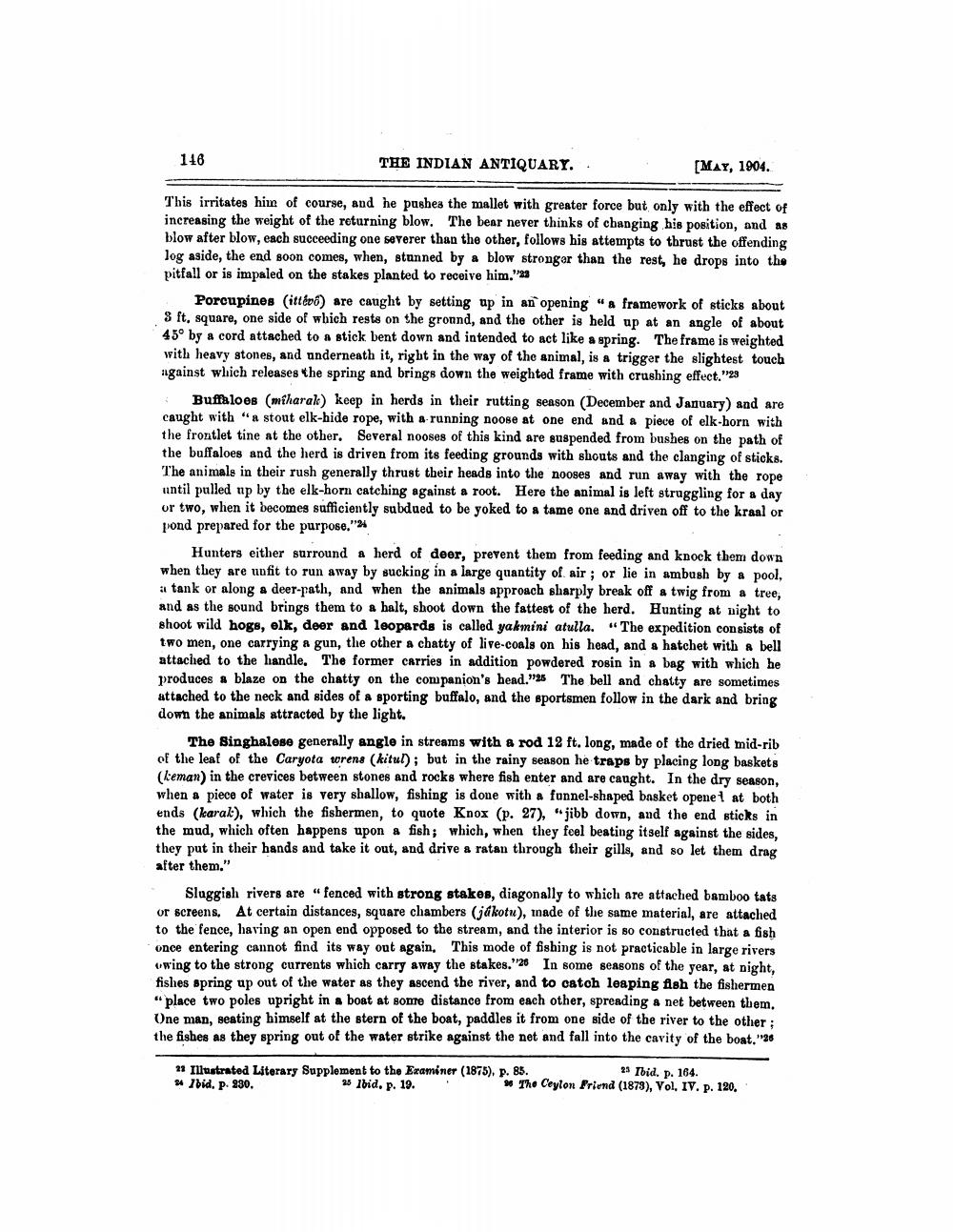________________
146
THE INDIAN ANTIQUARY..
MAY, 1904.
This irritates him of course, and he pushes the mallet with greater force but only with the effect of increasing the weight of the returning blow. The bear never thinks of changing his position, and as blow after blow, each succeeding one severer than the other, follows his attempts to thrust the offending log aside, the end soon comes, when, stunned by a blow stronger than the rest, he drops into the pitfall or is impaled on the stakes planted to receive him."
Porcupines (ittévá) are caught by setting up in an opening " framework of sticks about 8 ft. square, one side of which rests on the ground, and the other is held up at an angle of about 45° by a cord attached to a stick bent down and intended to act like a spring. The frame is weighted with heavy stones, and underneath it, right in the way of the animal, is a trigger the slightest touch against which releases the spring and brings down the weighted frame with crushing effect."23
Buffaloes (miharak) keep in herds in their rutting season (December and January) and are caught with "a stout elk-hide rope, with a running noose at one end and a piece of elk-horn with the frontlet tine at the other. Several nooses of this kind are suspended from bushes on the path of the buffaloes and the herd is driven from its feeding grounds with shouts and the clanging of sticks. The animals in their rush generally thrust their heads into the nooses and run away with the rope until pulled up by the elk-horn catching against a root. Here the animal is left struggling for a day or two, when it becomes sufficiently subdued to be yoked to a tame one and driven off to the kraal or pond prepared for the purpose."2%
Hunters either surround a herd of deer, prevent them from feeding and knock them down when they are unfit to run away by sucking in a large quantity of air; or lie in ambush by a pool, a tank or along a deer-path, and when the animals approach sharply break off a twig from a tree, and as the sound brings them to a halt, shoot down the fattest of the herd. Hunting at night to shoot wild hogs, olk, deer and leopards is called yakmini atulla. “The expedition consists of two men, one carrying a gun, the other a chatty of live-coals on his head, and a hatchet with a bell attached to the handle. The former carries in addition powdered rosin in a bag with which he produces a blaze on the chatty on the companion's head."25 The bell and chatty are sometimes attached to the neck and sides of a sporting buffalo, and the sportsmen follow in the dark and bring down the animals attracted by the light.
The Singhalese generally angle in streams with a rod 12 ft. long, made of the dried mid-rib of the leaf of the Caryota wrens (kitul); but in the rainy season he traps by placing long baskets (keman) in the crevices between stones and rocks where fish enter and are caught. In the dry season, when a piece of water is very shallow, fishing is done with a funnel-shaped basket opened at both ends (karak), which the fishermen, to quote Knox (p. 27), "jibb down, and the end sticks in the mud, which often happens upon a fish; which, when they feel beating itself against the sides, they put in their hands and take it out, and drive a ratan through their gills, and so let them drag after them."
Sluggish rivers are "fenced with strong stakes, diagonally to which are attached bamboo tats or screens. At certain distances, square chambers (ja kotu), inade of the same material, are attached to the fence, having an open end opposed to the stream, and the interior is so constructed that a fish once entering cannot find its way out again. This mode of fishing is not practicable in large rivers owing to the strong currents which carry away the stakes."26 In some seasons of the year, at night, fishes spring up out of the water as they ascend the river, and to catoh leaping fish the fishermen " place two poles upright in a boat at Bonte distance from each other, spreading a net between them. One man, seating himself at the stern of the boat, paddles it from one side of the river to the other : the fishes as they spring out of the water strike against the net and fall into the cavity of the boat."26
21 Illustrated Literary Supplement to the Examiner (1875), p. 85.
23 Tbid. p. 164. * Ibid. p. 230. 25 lbid. p. 19.
» The Ceylon Friend (1873), Vol. IV. p. 120.




